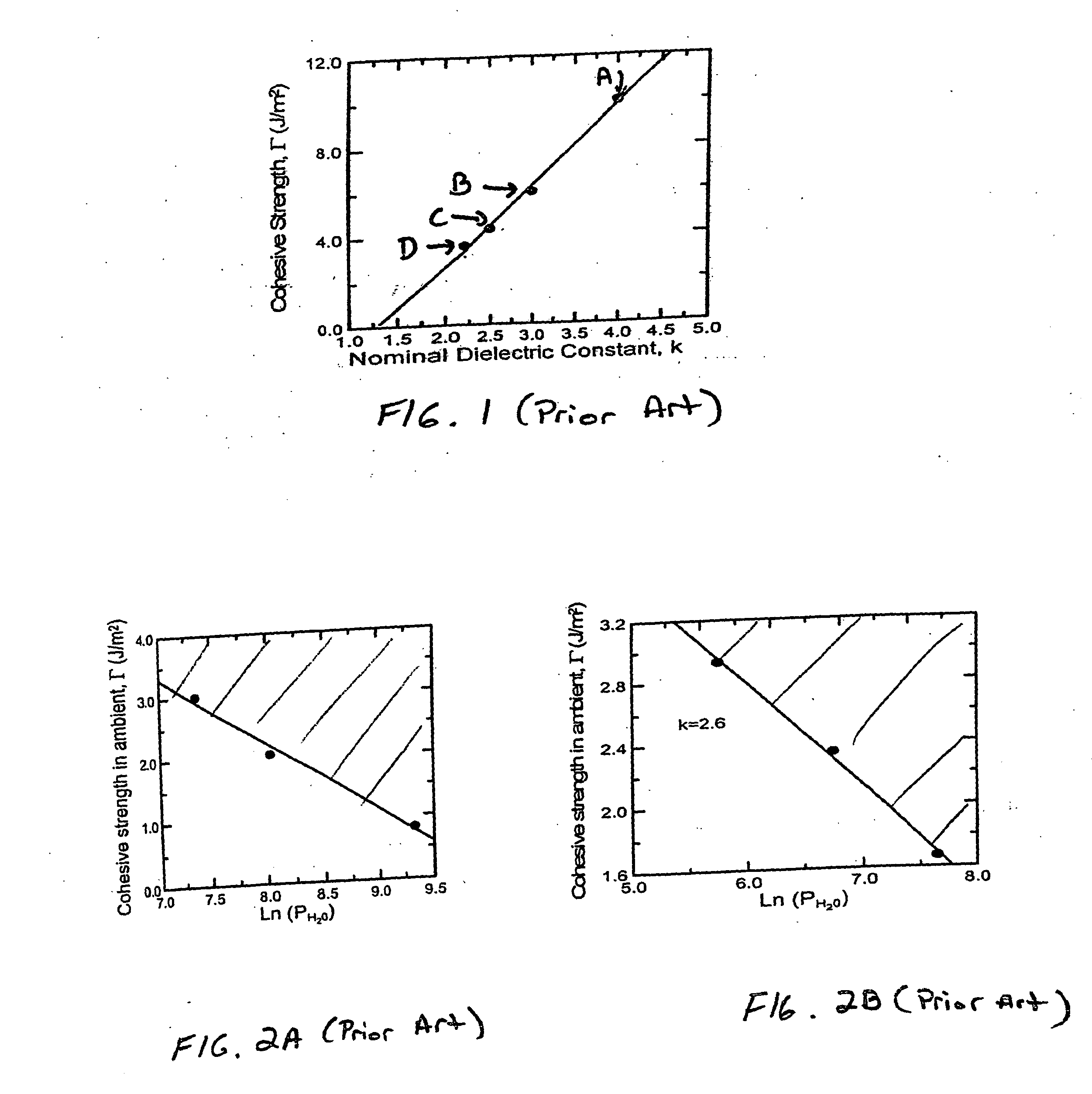SiCOH dielectric material with improved toughness and improved Si-C bonding, semiconductor device containing the same, and method to make the same
a dielectric material and toughness technology, applied in the direction of radiation control devices, transportation and packaging, coatings, etc., can solve the problems of increased signal delay in ulsi electronic devices, low cohesive strength, low elongation to break, etc., to improve the resistance and resistance of ulsi electronic devices, the effect of reducing the slope and small slop
- Summary
- Abstract
- Description
- Claims
- Application Information
AI Technical Summary
Benefits of technology
Problems solved by technology
Method used
Image
Examples
example 1
SiCOH material A
[0084] In this example, an inventive SiCOH dielectric, referred to as SiCOH film A, which was made in accordance with the present invention, was characterized by the data in FIG. 5 and in Table 1 below. For comparison, SiCOH films B and C are “typical” prior art SiCOH films, that have a dielectric constant about 2.7-2.8 are also shown in FIG. 5 and Table 1.
[0085] Referring to FIG. 5, this figure shows solid-state NMR (nuclear magnetic resonance) spectra for the 13C nuclei for the film SiCOH film A. Peak 33 corresponds to 13C for CH3 methyl groups bonded to Si, and the breadth of peak 33 is due to CH3 groups in different magnetic environments. The peak 32 was assigned to 13C in —CH2— species, bridging between two Si atoms, Si—CH2—Si. Based on the height of peak 32, the fraction of the total C in the film that is C present as methylene bridge groups, —CH2— was about 0.1. Since peaks 33 and 32 were overlapping, this was an estimate only. The areas have not been measur...
example 2
First Process Embodiment
[0087] A 300 mm or 200 mm substrate was placed in a PECVD reactor on a heated wafer chuck at 350° C. Temperatures between 300°-425° C. may also be used. Any PECVD deposition reactor may be used within the present invention. Gas and liquid precursor flows were then stabilized to reach a pressure in the range from 0.1-10 Torr, and RF radiation was applied to the reactor showerhead for a time between about 5 to about 500 seconds.
[0088] Specifically and for the growth of the inventive SiCOH dielectric material A containing enhanced Si—CH2—Si bridging methylene carbon (described above), the single SiCOH precursor was OMCTS (octamethylcyclotetrasiloxane) set at a flow of 2500 mg / m, an oxygen, O2 flow of 220 sccm, a helium, He gas flow of 2000 sccm, said flows were stabilized to reach a reactor pressure of 5 Torr. The wafer chuck was set at 350° C., and the high frequency RF power of 400 W at a frequency of 13.6 MHz was applied to the showerhead, and the low frequ...
example 3
Second Process Embodiment
[0089] A 300 mm or 200 mm substrate was placed in a PECVD reactor on a heated wafer chuck at 300°-425° C. and preferably at 350°-400° C. Any PECVD deposition reactor may be used within the present invention. Gas and liquid precursor flows were then stabilized to reach a pressure in the range from 0.1-10 Torr, and RF radiation was applied to the reactor showerhead for a time between about 5 to 500 seconds.
[0090] Specifically and for the growth of the inventive SiCOH dielectric containing enhanced Si—CH2—Si bridging methylene carbon (described above), the conditions used include: 1,1,1,3,3,3-hexamethoxy-1,3-disilapropane, flow of 2500 mg / m, an oxygen, O2 flow of 220 sccm, a helium, He gas flow of 2000 sccm, said flows were stabilized to reach a reactor pressure of 5 Torr. The wafer chuck was set at 350° C., and the high frequency RF power of 500 W at a frequency of 13.6 MHz was applied to the showerhead, and the low frequency RF power of 160 W at a frequency...
PUM
| Property | Measurement | Unit |
|---|---|---|
| dielectric constant | aaaaa | aaaaa |
| temperature | aaaaa | aaaaa |
| dielectric constant | aaaaa | aaaaa |
Abstract
Description
Claims
Application Information
 Login to View More
Login to View More - R&D
- Intellectual Property
- Life Sciences
- Materials
- Tech Scout
- Unparalleled Data Quality
- Higher Quality Content
- 60% Fewer Hallucinations
Browse by: Latest US Patents, China's latest patents, Technical Efficacy Thesaurus, Application Domain, Technology Topic, Popular Technical Reports.
© 2025 PatSnap. All rights reserved.Legal|Privacy policy|Modern Slavery Act Transparency Statement|Sitemap|About US| Contact US: help@patsnap.com



